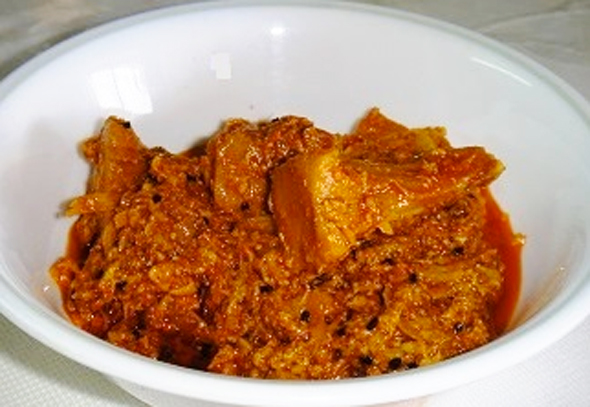Mama’s Punjabi Recipes: Kathal da Achaar (Pickled Jackfruit)
It would be fair to say that, among Punjabis, kathal (jackfruit) is a very underrated and misunderstood vegetable and perhaps even less appreciated as a fruit when it is the sweetest. It is hardly the vegetable that most housewives in Delhi go to first as it is so large to manage. It is quite difficult to peel the prickly skin and then separate the pulp from the almond shaped seeds which are similar to chestnuts.
Kathal is native to the Western Ghats of India, all the way down to the Malabar Coast, and also West Bengal. In Malayalee it is called chakka and kathal in Bengali. As a vegetable you have to choose a green, unripe raw kathal which has a subtle taste of its own and absorbs other flavors easily. Ripened ones are very sweet and are eaten as a fruit which tastes like is a mix of apple, pineapple, mango and banana. In North India, it is usually cooked around Holi when it is in season.
Kathal is popular because its texture is starchy and fibrous and once cooked in a curry, people call it the “vegetarian’s meat” which is often compared to poultry, because of the way it crunches when bitten. The pulp of the jackfruit is 74% water, 23% carbohydrates, 2% protein and 1% fat. It is a rich source of vitamin B6 and has moderates amounts of vitamin C and potassium.
Green kathal can be sautéed or cooked in a curry, but is also popular as pakoras (fried fritters) with some chutney. It can also be eaten as an achaar (pickle) which is often compared to the King of Indian pickles, ambh da achaar (mango pickle).
Ingredients:
500 gm kathal (jackfruit)
100gm sarson da tael or mustard oil
1 tsp rai (mustard seed)
1 tbsp methi danna (fenugreek seed)
1 tbsp saunf (fennel seed)
1 tsp haldi (turmeric)
1 tbsp namak (salt)
1 tsp lal mirch (red pepper)
4 cups pani (water)
Directions:
1. Peel the thick skin to the inside, then cut the kathal length wise, about 1 inch long and about 1/2 inch thick slices. Discard the seeds.
2. Bring the water to boil in a pan. Turn the heat off and drop the cut kathal into the pot, cover with a lid and let sit for 5 minutes.
3. Drain the water; place the kathal pieces on a large towel and let them dry completely.
4. When dry, place in a bowl, pour in some of the mustard seed oil, salt, red pepper and stir to coat well. Transfer the kathal, spices and oil into a glass bottle.
5. Pour the methi danna and saunf in a mortar and crush them with a pestle, into rough but not fine pieces. Now pour in the remaining salt, pepper, turmeric and mustard seeds and mix.
6. Pour the mixed spices into the bottle and shake well. Pour in enough oil to cover the kathal.
7. Let the bottle sit in the sun for a few days, shaking the contents throughout the day and make sure to keep the kathal coated with oil so that it will preserve the vegetable for a long time.
8. After two weeks, serve with any assortment of meals.
MAMA’S TIP OF THE WEEK
MANGO PICKLE MASALA ADDS MORE FLAVOR TO KATHAL PICKLE
The achaar with the largest following, amb da achaar (mango pickle) has a thick inner seed shell that is left onto the young green unripe mangoes. It the same way, kathal pickle has a hardened outer peel that is tossed out when eating. The style of masalas (spices) for both achaars is also very similar.
So, if you have some mango pickle that is ready to be finished, you can use the leftover masala and mix it in while making the kathal. This will bring in more flavor when you add the rest of the mustard oil and other spices.

Shakuntla Malhotra is a skilled cook of Punjabi dishes made in the old-fashioned style that she learnt as a young woman in her ancestral home in Lyallpur (since renamed Faisalabad), India before it became part of Pakistan after the Partition in 1947. People have often admired her cooking for its simplicity and taste that comes with each mouthful. Even in her mid-eighties, she continues to cook daily and agreed to share some of her delectable Punjabi recipes

